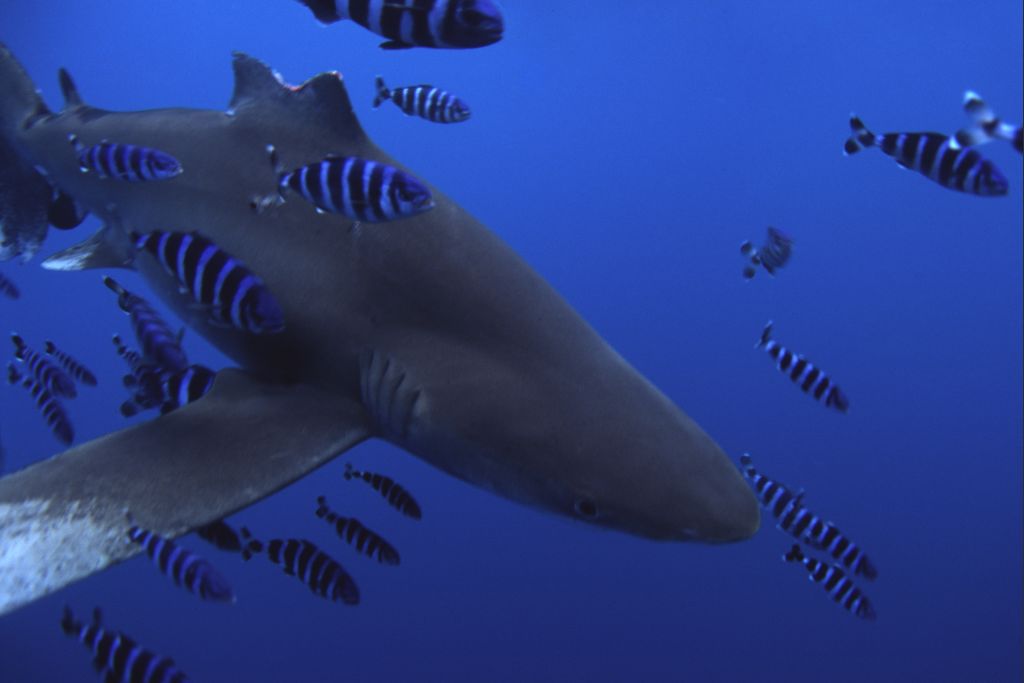Shark Tracking Apps for your phone or tablet.
![]()
OCEARCH Shark Tracker
Track sharks in near real-time

Dorsal Shark Reports
Dorsal is the worlds most advanced shark reporting and alerts solution. It is a free community based shark alert solution that allows beachgoers and authorities to immediately alert others to shark sightings or attacks in their area.
Shark Tagging & Tracking: Separating Fact from Fiction
The article below was written and originally published on the National Geographic Blog by Neil Hammerschlag, the Research Associate Professor at the University of Miami, Rosenstiel School of Marine & Atmospheric Science Dedicated to advancing marine conservation through research, education and outreach
For several years now, I have been using electronic tagging to study the movements and behaviors of sharks. You can find out more about this research HERE and watch a video HERE.
I previously wrote about the state of electronic tagging and tracking marine animals. However, recently there have been a lot of myths, false criticisms and misinformation being spread about shark tagging and tracking research. Here I list and address some of these common myths or misinformation and use examples based on my personal experience and research.
Does tagging cause shark’s pain?
No. Recent research shows that the sensory receptors (known as nociceptors) responsible for feeling pain in humans and other mammals are not present in the sharks studied to date. Moreover, many tags are attached to shark fins, which have no nerve supply. The type of response to injury that sharks exhibit is unconscious reaction or reflexes, not pain-induced response. For more information on sharks and pain, please click Here & Here
Do publishing shark movements tell fishers where they are and make them more vulnerable to exploitation?
No. The reality is that fishing is everywhere. Except where they are already protected and properly managed, there is no place where sharks are safe from fishing (see image below). The fishing industry is way ahead of scientists in terms of knowing where the sharks are. Sometimes, the fishing industry even hires oceanographic data analysts to identify potential fishing “hot spots” in real time, reporting these locations to fishers at sea. It is scientists that are playing catch up and the tracking data generated is used to help managers make informed conservation decisions (Excerpts from HERE). In addition to publishing our data in scientific reports, our lab website also provides an online interactive google earth map, allowing the public to track our sharks. To us, the tracking data not only helps conservation management, but the educational benefits of the online tracking helps generate public awareness and support for shark conservation. Our online tracking system does not provide GPS coordinates and also utilizes a time-delay to prevent the possibility of someone trying to find and catch the tracked sharks. That said, at times it is necessary to keep some information “privy” (i.e., shared only with regulators) such as the location of a specific unknown aggregation site, but such instances are uncommon.

Does attaching tags to shark fins cause permanent damage that can influence shark survival?
No. While tags mounted to fins may cause fin irritation, drag or even result in fin damage, there is no evidence to date suggesting that it will impact the survival of sharks. In fact, most sharks swim around with severely deformed or damaged fins as a result of fighting and in many cases mating, where males bite females on the fins to enable mating (see image below). Some of the damage can be extreme, but sharks are also well-known for their remarkable “healing power”, and shark fins, like fingernails, can regenerate to a large extent. Many tags that are attached to shark fins are non-permanent; some are programmed to detach, some are created to corrode off or fall out, and in some circumstances the shark fins can heal around the tag, forcing the tag to ‘migrate’ out the fin. Ideally, tags should be engineered to have the least impact on the animal’s health, programmed to release or designed with materials that cause the tag attachment points to corrode and/or detach at some point. While each research team uses different methods (and therefore each researcher is the best person to comment on his or her own tagging work), our fin-mounted tags are attached with medical-grade, bio-compatible, titanium that ensures it will corrode (usually in less than a year). Like many other research groups, we also coat our tags with anti-fouling paint to prevent organisms from growing on the tags. I believe that the potential negative effects on the sharks from tags are minimal considering the research and education benefits it provides, which will help protect these threatened species. For more information, please read our paper on satellite tags, which further discuss the potential negative impacts of tags on sharks.

Can shark tracking data help with shark conservation?
Yes. In many cases, policy makers have been unable to conserve threatened sharks due to the lack of appropriate data on shark movements and behaviors, data which tagging and tracking work can provide. Moreover, Vessel Monitoring Systems (VMS) that track the movements of fishing boats through satellites in combination with real-time tracking of sharks can be used by management agencies to set protection boundaries around shark aggregations or insure that fishing vessels are not moving into core areas the sharks are using. Some of the other conservation benefits of tagging and tracking data include:
- Revealing key areas to prioritize for protection, such as mating, feeding or nursery grounds.
- Determining sites where sharks are most likely to interact with fishing activities
- Evaluating whether marine protected areas are sufficiently sized or placed to adequately protect sharks
- Predicting the impact of climate change on shark movement and distributions

Do electronic tags interfere with shark electro-magnetic senses?
No. There is no scientific evidence that satellite tags interfere with shark senses. Martin (2003) wrote “despite the phenomenal electrosensitivity some elasmobranchs have demonstrated under laboratory conditions, the functional distance of a White Shark’s — or other elasmobranch’s — ampullae of Lorenzini in the wild may be limited to very short distances (say, on the order of a foot [30 centimetres] or less). So, unless the power pack of an electronic tag is strapped to the underside of a shark’s snout, it seems unlikely that the tiny energy output of an Archival satellite tag would significantly affect a shark’s ampullae of Lorenzini or behavior.” For further discussion, click HERE.
Is shark tagging a science?
No. Shark tagging is a research technique and tags are a research tool. It is no different than a hammer for a carpenter. The scientific process includes designing a project to test hypotheses or address study objectives. In fact, it is quite easy for anyone to purchase tags and attach them to a fish; however, that does not mean that the tagger is a scientist more than a person hammering in a nail is a carpenter.
Is shark tagging & tracking essential to study sharks?
No. Electronic tagging is a relatively new scientific tool. Depends on the question being addressed; some questions do not require tagging, while others do. For example, over the past 10 years I have studied and published on the hunting behaviors of white sharks in South Africa based purely on observations from a boat. However, our lab has satellite tagged over 100 tiger, bull and hammerhead sharks to address a variety of research questions that have required tagging. In the end, tags are just one tool in the toolbox available for the study of wild sharks.
Is there an authority that reviews and provides permission for scientists to tag sharks?
Yes. Tagging is only implemented after a long process of proposals and approval. First, the study needs to be funded, which requires writing a proposal that is first reviewed and assessed by a funding agency. Next, the study often needs to be approved by the Animal Welfare and Care Committee of the researcher’s institution. Finally, the study requires permitting from the government in which the study is being conducted. Along each step of the process the researcher needs to justify the study need, significance and methodology taking into account animal welfare needs.
Are scientists and engineers working to improve tagging technology and practice?
Absolutely. Scientists and engineers are constantly working together to improve tag performance, power, data acquisition, sensor capabilities, data acquisition attachment techniques as well as reduce tag size, drag and improve animal welfare.






